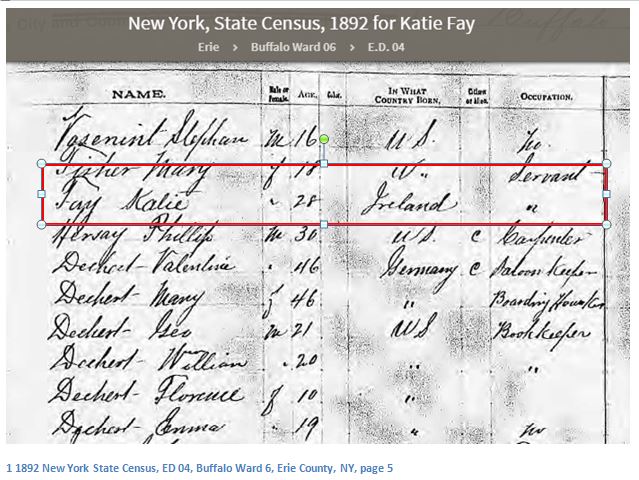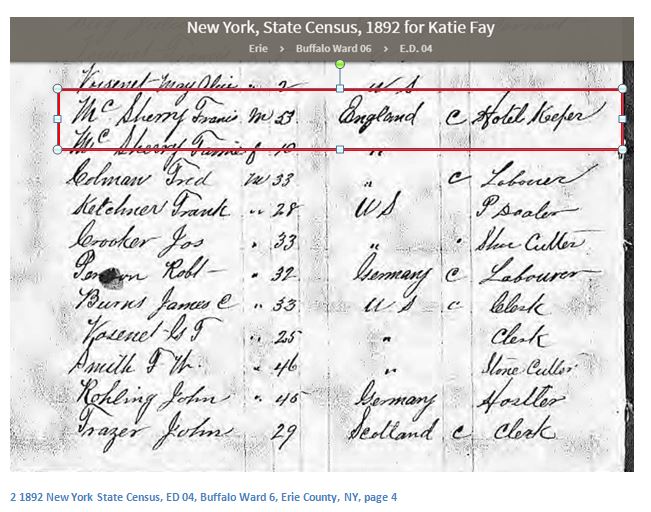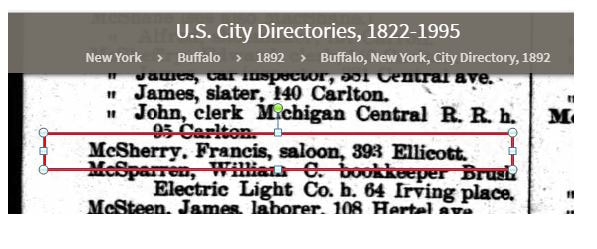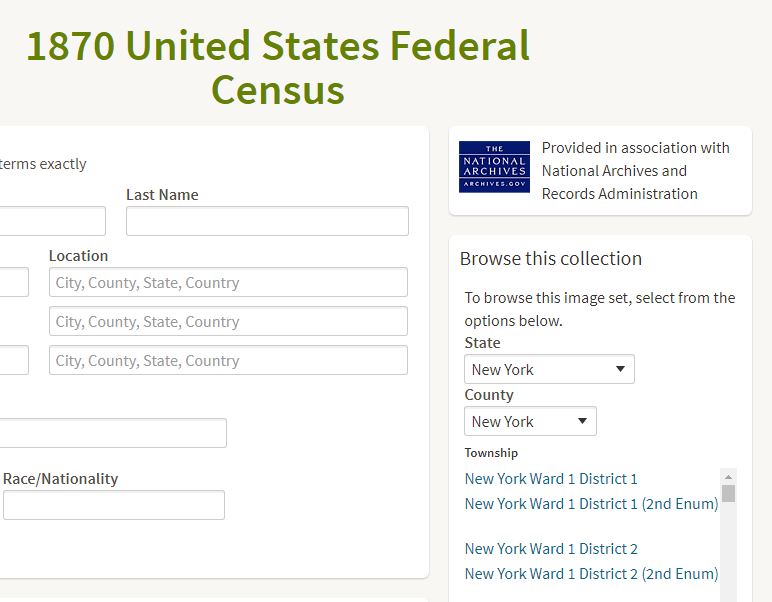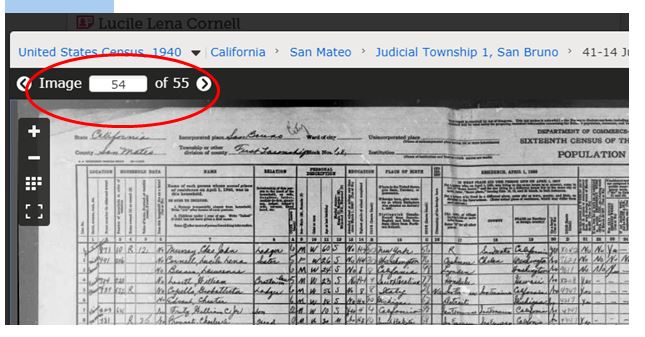|
Boy, wouldn’t you like to be able to find your great-grandparents marriage record? But you feel like you have no idea where to start. Just take it one step at a time, and wring every clue out of every document, even those clues that are hidden. I’m searching for the marriage record of Joseph Lawson and his wife, Katherine Fay. They married in 1894, according to a history book about the maritime history of the Great Lakes.[1] Though the 1890 US Federal census was destroyed, I’m fortunate that New York State took a census in 1892 and I’ve found likely candidates for both Joseph and Katherine in Buffalo. But the big problem with that 1892 census is there are no addresses on it. If I knew what her address was in 1892, I’d have some idea where she likely went to church, which might give me a clue where she was married so I can get the parish register. But with no address on the census, and the young lady I’m looking at a servant girl who isn’t listed in a city directory, I’m kind of stuck. Katie is listed Fourth Election District of the Sixth Ward. I could probably do some research to figure out what that is, but it may be a big area, and I still won’t know her address. But I can dig a little into Katie’s household. The 1892 census in Buffalo doesn’t separate the households in any way. Katie is the third name down, then I see a different surname, and then a bunch of people named Dechert, which looks like a new household to me. So I just need to scroll up Katie’s household in the previous column to see if I can find someone who looks like the head of Katie’s household. The household has clerks and laborers, a hostler and some others, but as I scroll up, I see Francis McSherry a hotel keeper. This looks like his household and the dozen or so names beneath his are boarders in his establishment. And I know a man with a hotel is likely to be listed in a city directory. 393 Ellicott. I have an address for Francis, which give me an address for Katie. And using that same city directory I can see Joseph Lawson lived at 420 Fargo in Buffalo. With that address it ought to be pretty easy to map the Catholic churches around their two addresses, and start looking for their marriage record. Wring every clue out of your documents, even those hidden clues. [1] Profile of Joseph Lawson from History of the Great Lakes,( http://www.maritimehistoryofthegreatlakes.ca/GreatLakes/Documents/HGL2/default.asp?ID=s683 – accessed 25 July 2017)
2 Comments
My title is one of those adages I remember my father saying in my childhood. Dad wasn’t teaching me genealogy, but that lesson definitely should be applied to using the census. What were the instructions for the census taker, anyway? Every ten years, enumerators knocked on doors and asked questions of the inhabitants of the houses. They filled in the responses on a one-page form. Before they began their duties, they were trained and given voluminous instructions. For example, the 194 instructions to the 1910 census fill 11 pages. Regarding nativity and mother tongue, instruction #123 states “If the person was born abroad, but of American parents, write in column 12 both the birthplace and Am. cit.-that is, American citizen. If the person was born at sea, write At sea.”[1] A 1930 instruction regarding occupations states “Builders and contractors-Only persons engaged principally in securing and supervising the carrying out of building or other construction contracts should be returned as builders or contractors. Craftsmen who usually work with their tools should be returned as carpenters, plasterers, etc., and not as contractors.”[2] For the 1850 census there’s a specific instruction for men of the cloth, “When the individual is a clergyman, insert the initials of the denomination to which he belongs before his profession - as Meth. for Methodist, R.C. for Roman Catholic, O.S.P. for Old School Presbyterian, or other appropriate initials, as the fact may be.”[3] That little notation may help you find a church record when you research the name of the clergyman on your ancestor’s marriage record. The enumerators were given detailed instructions as to just what sorts of responses were acceptable. If you want to understand what they wrote, you need to understand what they were allowed to write as a suitable answer. A wonderful website, IPUMS, the Integrated Public Use Microdata Series, holds lists of all the census questions and instructions for the US Federal Census from 1850 through 2000 and beyond. You can find it at https://usa.ipums.org/usa/voliii/tEnumForm.shtml. It will provide answers to questions you never knew you had. Before you look at any census, be sure to read the instructions! [1] https://usa.ipums.org/usa/voliii/inst1910.shtml [2] https://usa.ipums.org/usa/voliii/inst1930.shtml [3] https://usa.ipums.org/usa/voliii/inst1850.shtml 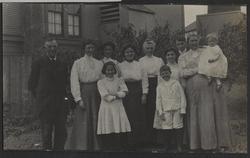 The Bradley Family in Tiburon, California, circa 1910. Back row, left to right, Patrick Thomas Bradley, Agnes Bradley Kircher, Lizzie Bradley, Kathryn Frances Murphy, Catherine Bradley Murphy, Rosella Graham, Hilary Bradley, Mary Agnes Ahern Bradley, Mary Frances Kircher. Front row: Miriam "Brownie" Bradley, Graham Bradley The Bradley Family in Tiburon, California, circa 1910. Back row, left to right, Patrick Thomas Bradley, Agnes Bradley Kircher, Lizzie Bradley, Kathryn Frances Murphy, Catherine Bradley Murphy, Rosella Graham, Hilary Bradley, Mary Agnes Ahern Bradley, Mary Frances Kircher. Front row: Miriam "Brownie" Bradley, Graham Bradley “Miss Rosella Graham, daughter of A. D. Graham of El Verano, was run down by a team of horses Tuesday while riding a bicycle. She is still suffering for the effects of the injuries, which will not prove fatal.”[1] Thank goodness those injuries did not prove fatal. Rosella, was my great aunt, and I have fond childhood memories of all 4’11” of this little old lady. She joined the Bradley family when she married my grandmother’s brother, Hilary Bradley, in 1913. Rose died in 1985, somewhere in her mid- to late-90s. It’s not clear exactly how old she was, because when she married Hilary, she was at least a few years older than he. She didn’t want anyone to know, so she burned, buried or otherwise destroyed any evidence, lying about her age… until she hit 90, when it because something of a status symbol to have lived so long. By then she wanted to take full advantage of the respect accorded to such a venerable character and she raised her age by 2 (or 3) years between the birthday celebrations. I’m visiting California for “The Bradley Picnic,” a reunion of the Bradley family. I came a few days early and my dear sister, Diane, who knows how passionate I am about my genealogy, offered to drop me off at the Santa Rosa library while she ran some errands. Talk about hog heaven! And scrolling through newspapers, I found the above article about the bicycle and the horses. At our picnic yesterday, I mentioned it to Rose’s granddaughter and her husband, Mary and Len. Mary recalled the story, remembering seeing evidence of the injury years later, a “hole” in Rose’s thigh that never quite healed. The story as Mary recalled was that Rose was hit by a car, not a team of horses. Rose never placed any blame on the driver, saying it was her own fault for riding into the road right in front of the vehicle. But the cool part of the story was the identity of the driver. Not mentioned in the newspaper, but according to Rose (well Mary’s recollection of what Rose told her), it was none other than Jack London. Rose reported that Jack London had the first automobile in Sonoma. After the party ended, I spent a little time trying to research this. Could it have been Jack London? He certainly was in town that week, and he loved his horses. The Press Democrat from 9 June 1905, reported that London had recently ridden from Sonoma to Santa Rosa to see his good friend, Luther Burbank. “Frequently during the last two or three months, Mr. London and Miss Kittredge have enjoyed horseback rides all over the Sonoma Valley and to Santa Rosa, Altruria and other places. Both are passionately fond of horseback riding.”[2] A few years later he spoke about his Sonoma farm to a reporter for the Sacramento Union, “’I’ve the finest lot of horses over there you’d see anywhere… just see’ – he rolled up the sleeve of his right arm and proudly exhibited a rigid muscle – ‘got that from driving a four-horse team. I’ve sailed a bit in my time and done other hard work, but I never developed that muscle until I took to driving. It’s great.’”[3] I searched the newspapers to see if I could confirm a story about London owning an automobile but I found nothing. A man of his means could very well have had the first auto in the town. Maybe London was driving an auto and spooked a horse-drawn wagon causing the collision with Rosella. But it’s also clear London enjoyed driving a team of horses. So maybe Rose did collide with Jack. And knowing me, this is probably not the end of my research into this story. I’ll keep you posted. I’m sure glad I found that article about Rose and the bicycle just in time for the Bradley picnic and the opportunity to hear a bit more about it from her granddaughter. Do you have a family story about a celebrity? Have you proved it or disproved it? Feel free to post a comment below and tell me your story. [1] Petaluma Morning Courier, 3 June 1905, page 4, col. 3 [2] Press Democrat, 9 June 1905, page 7, col. 2 [3] “Jack London Fulfills His Youthful Vows With Sutter Fort Pilgrimage,” Sacramento Union, 9 December 1912, page 1 col 5 and page 3 col. 5 I recently presented “Censational Census Strategies” for Legacy Family Tree Webinars. In it, I mentioned the second enumeration to the 1870 census. The 1870 census is purported to be the worst US census ever taken.[1] There were enough people missed and enough errors that a second enumeration was ordered for a few large cities, including New York City. This second enumeration was taken in January of 1871. How can you find this second enumeration? If you have an Ancestry.com subscription, you can do a search for the 1870 census. Once you get there, on the right side of the screen you will see "Browse this collection" and you can specify your state (NY) county (NY) and then use the dropdown for the town and you will see something like: “New York Ward 1 District 1,” then ”New York Ward 1 District 1 (2nd Enum).” You can then browse through the pages. However, you may not know the Enumeration District (ED.) If you don’t have an Ancestry.com subscription, you may have access to HeritageQuest databases from home using your library card. This is one of the databases many libraries provide to their patrons, for free, from home. Look on your library’s website for something like “Research“ or “Databases” and then for a Genealogy or History category. Again, if you don’t know your ancestor’s ED, this might not be so useful. I would suggest you just do a straight up name search for your ancestor, and try to find them on both enumerations. If you can only find them on one, pick 3 or 4 neighbors on that enumeration, and then look for them on the other enumeration, and see if you can't find your ancestor. Hope that helps! [1] http://stevemorse.org/census/1870secondenumeration.html When you’ve found your family on the census, do you look at the last page in their Enumeration District (ED)? Maybe you should. When the census enumerator completed his rounds and had a list of every name in the district, often he had to make a copy. But what if he missed a name when rewriting the list? He might have listed all those missing names at the end of the ED. You can get to these final pages of an ED on Ancestry by looking at image numbers. Here’s an image from an ED in San Bruno, San Mateo, California in 1940. You can navigate to any image within this ED simply by typing the image number in the box at the bottom. You can see I’m on Image 54 or 55, so right near the end. Look carefully at this page, and you will see that the third and fourth columns, “House No.” and “Visited No.” are quite out of order. Almost everyone on this page “belonged” in a household which was enumerated on a previous page. Perhaps the enumerator forgot to write them down on his original list and had to “catch up” at the end. If you are using FamilySearch for your census images, you also have an option to select a particular image in the set. Some enumerators even used the last page of their counts to write some notes about what they encountered while performing their census duties. Make sure to check the last pages for all the enumeration districts you look at. You just never know what you might see there! For more census tips, check out my "Censational Census Strategies" webinar on Legacy Family Tree webinars, or look for the category "Census" here on my blog. |
AuthorMary Kircher Roddy is a genealogist, writer and lecturer, always looking for the story. Her blog is a combination of the stories she has found and the tools she used to find them. Archives
April 2021
Categories
All
|
